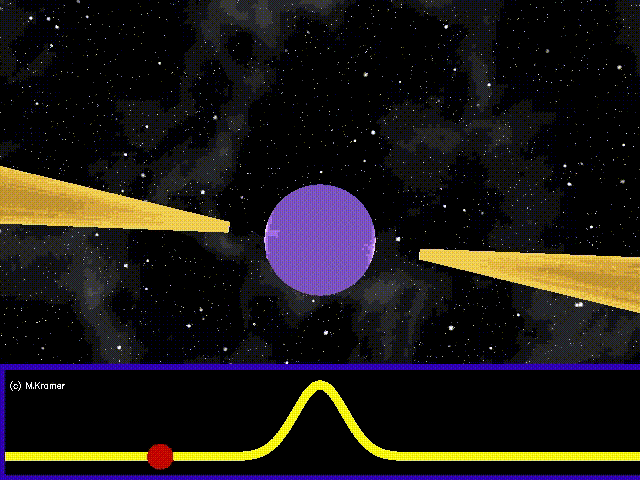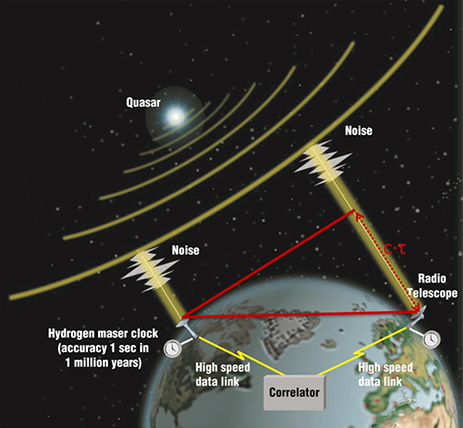Research with Ooty Radio Telescope
Over the 50 years, the ORT has produced many important astronomical results on radio galaxies, quasars, supernovae, pulsars, the interstellar and interplanetary media, etc. One of the most successful observational programs carried out for many years at Ooty was to determine the angular structures of hundreds of distant radio galaxies and quasars by the technique of lunar occultation. The application of this unique database to observational cosmology provided independent evidence against the Steady-State theory of Universe and supported the Big-Bang model of the Universe.The telescope is currently being used mainly for the study of pulsars, radio recombination lines and interplanetary scintillations.
Pulsar Observations
Pulsar Research with the ORT: Pulsars are rapidly rotating neutron stars in which the radio emission arises by curvature radiation in a narrow cone around the magnetic field lines. This cone sweeps past the observer like a lighthouse beacon. Thus the observer receives a narrow pulse of radio emission during each rotation of the neutron stars. Observations with the ORT during 1970s led to discovery of eight new pulsars, including a pulsar with unusually large pulse-width.

Artist's impression of a pulsar.The lower panel shows the pulsed emission observed by our telescope . (Image credit: Michael Kramer) due to the beaming of the radiation, known as the "lighthouse effect".
The Pulsar Ooty Radio Telescope New Digital Efficient Receiver (PONDER), which has been designed to operate along with the legacy analog system of the Ooty Radio Telescope (ORT). PONDER makes use of the current state of the art computing hardware, a Graphical Processing Unit (GPU) and sufficiently large disk storage to support high time resolution real-time data of pulsar observations, obtained by coherent dedispersion over a bandpass of 16 MHz. Four different modes for pulsar observations are implemented in PONDER to provide standard reduced data products, such as time-stamped integrated profiles and dedispersed time series, allowing faster avenues to scientific results for a variety of pulsar studies.

Additionally, PONDER also supports general modes of interplanetary scintillation (IPS) measurements and very long baseline interferometry data recording. The IPS mode yields a single polarisation correlated time series of solar wind scintillation over a bandwidth of about four times larger (16 MHz) than that of the legacy system as well as its fluctuation spectrum with high temporal and frequency resolutions. The key point is that all the above modes operate in real time. This paper presents the design aspects of PONDER and outlines the design methodology for future similar backends. It also explains the principal operations of PONDER, illustrates its capabilities for a variety of pulsar and IPS observations and demonstrates its usefulness for a variety of astrophysical studies using the high sensitivity of the ORT".
Interplanetary Scintillation
The IPS technique exploits the scattering of radiation from compact components of quasars and radio galaxies by the solar wind density irregularities, which are moving radially outward from the sun. The importance of the Ooty IPS measurements increased when the day-to-day monitoring of the helio-sphere was made on a grid of large number of radio sources (∼800–1,000 per day), whose lines of sight cut across different parts of the heliosphere. The Ooty IPS studies have provided for the first time a complete coverage of the imaging of CME structures all the way from the sun to the earth. The solar wind measurements at Ooty over the solar cycle 23 provided the large-scale changes of latitudinal features of the solar wind density turbulence and speed. Routinely imaging of solar wind disturbances at Ooty in the sun-earth distance has provided a capability to predict the adverse space-weather events before their arrival at the near-earth environment.

The new technique developed at Ooty to study the interplanetary scintillation observations provides valuable information about the solar wind and solar-wind magnetic storms that affect the near-Earth environment. Major eruptive events on the Sun, such as flares or coronal mass ejections (CMEs), can have a profound influence on the terrestrial environment. CMEs can interact with Earth's magnetosphere to generate major geomagnetic storms and substorms, sometimes affecting communication and power grid systems and accelerating energetic particles that have been known to damage communications satellites and may harm astronauts working in space. Ooty scintillation measurements are useful in identifying and understanding the evolution of disturbances caused by powerful CME events in the Sun-Earth distance and forecasting the arrival of such large events at the near-Earth space.
The objective of the Ooty scintillation study is to significantly advance the understanding of the three-dimensional (3-D) structure and evolution of CMEs and their interaction with the interplanetary medium and terrestrial magnetosphere using combined imaging, radio, and in-situ measurements from spacecraft. Ooty measurements have been successfully employed to track CMEs from Sun to Earth distance and they have elucidated the evolution of the 3-D structure and speed of CMEs in the inner heliosphere. Interplanetary scintillation observations also provide a valuable database to understand the Space Weather changes and its predictability.
Very Long Baseline Interferometry

(VLBI is a geometric technique; it measures the time difference between the arrival at two Earth-based antennas of a radio wavefront emitted by a distant quasar)
For example, by using atomic clocks, which provide excellent time and frequency standards, ORT has been used to do very long baseline interferometry (VLBI) by combining the radio waves received by them with those received by radio telescopes in West Germany, Holland, England, Japan, Poland, China, and Russia. This has enabled celestial objects like radio galaxies and quasars to be observed with very high resolution, equivalent to that obtained by a telescope with an aperture size of about 5000 km.
